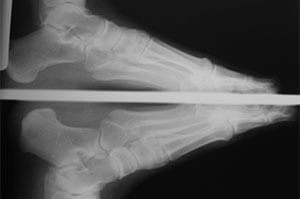 “The podiatrist’s assistant put me in the chair, the podiatrist came in and said hi, asked me what’s wrong and after I told him where I have pain he looked at my foot, took an x-ray and told me I needed surgery, the sooner the better or it will get worse.”
“The podiatrist’s assistant put me in the chair, the podiatrist came in and said hi, asked me what’s wrong and after I told him where I have pain he looked at my foot, took an x-ray and told me I needed surgery, the sooner the better or it will get worse.”
What’s wrong with this? Everything!
There was NO
- … examination of both feet
- … testing of the nerves and reflexes, blood supply
- …testing of the range of motion of the important parts of the foot and ankle.
- … detailed discussion of your complaint, how long you had it,
- …discussion concerning your attempts at treatment./li>
- … discussion of alternative treatments
- … discussion as to why the surgery has to be done as soon as possible.
If the following things did not take place during your first visit to your podiatrist, and if you believe you are the victim of that podiatrist’s mistake, you should contact me for legal advice:
History:
 Your podiatrist should take a thorough history, have you fill out a questionnaire, and have you write down what your complaints are and why you seeking a podiatric examination. In all too many cases I see the podiatrist writing down the reasons for the visit just to justify surgery. That’s why it is important for you to be given the chance to write it down yourself someplace in the podiatrist record. If you have anything in your history involving foot surgery or foot conditions, your podiatrist should spend time and ask you about it. And your podiatrist should ask you about your level of activity especially if engage in sports or exercise.
Your podiatrist should take a thorough history, have you fill out a questionnaire, and have you write down what your complaints are and why you seeking a podiatric examination. In all too many cases I see the podiatrist writing down the reasons for the visit just to justify surgery. That’s why it is important for you to be given the chance to write it down yourself someplace in the podiatrist record. If you have anything in your history involving foot surgery or foot conditions, your podiatrist should spend time and ask you about it. And your podiatrist should ask you about your level of activity especially if engage in sports or exercise.
Examination:
The examination of both feet probably should include:
- a detailed discussion of your complaint, how long you had it, what makes it worse
- testing of the nerves, reflexes, and blood supply
- measuring the range of motion of the those parts of the foot and ankle which relate to your complaint
- look at your shoes and discuss with you how they feel and fit
- pressing on parts of the foot to try to elicit pain (medically this is called “tenderness”)
- discussion of the podiatrist’s findings and what they mean as far as your complaint
- discussion as to what can be done ranging from the easiest, least risky to the more complicated.
- if surgery is the only answer to your problem, then the podiatrist should explain why
Plan for Treatment
If the only plan for treatment is surgery – you should get another opinion. While there are conditions which can only be fixed with surgery, you should never rush to have surgery.
The plan should include:
- possible treatments NON-surgical such as changing shoes (even if you have to abandon stylish shoes and heels)
- other treatments such as modifying your shoes, inserts and custom orthotics
- possible medication (anti-inflammatories) and injections (be careful the injection happy podiatrist – too many injections can damage you)
- changing your activity: less walking and standing for example, or proper shoes for sports and exercise
- Surgery – if all else fails, then consider surgery, but only after you get a second opinion
